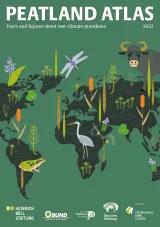
Reeds are used to make thatch for roofs, and grass fibres are used to make furniture: paludiculture combines peatland conservation with agriculture. Strong political support is needed to give this sustainable way of using rewetted peatlands a chance of success.

Many peatlands were originally drained to create husbandry or for peat extraction. Rewetting does not mean that they should be left unused. The use of wet and rewetted peatland for agriculture or forestry is called paludiculture. This concept was developed more than 20 years ago. The name comes from palus, the Latin word for swamp. While drainage aims to subject an organic soil to a particular type of land use, paludiculture allows it to be used in accordance with the natural conditions. It stops peat decomposition and reduces greenhouse gas emissions. The idea is to maintain high water levels that keep the peat completely waterlogged all year round, so preserving the peat.
Typical paludiculture plants are those that can cope well with these high moisture levels and whose above-ground biomass has an economic use: they include reeds, peat mosses, rushes, papyrus, alder, sedges and other grasses. Paludiculture does not focus on food production, but on renewable raw materials that can be used in construction, as insulation or in manufacturing. Biomass from paludiculture can also be used to produce paper, cardboard, other packaging materials, and bio-based chemicals used to make pharmaceuticals, along with resins and bioplastics. It is also possible to raise livestock on wet, swampy land. Water buffaloes, for example, have wide hooves that make them suitable for use in landscape maintenance. Peat moss, bulrushes and reed produce a variety of raw materials for substrates for peat-free horticulture. Energy can also be produced with paludiculture biomass. Local power stations can burn hay harvested from wet meadows to produce heat for many homes.
Papyrus is a highly productive aquatic perennial with stout stems that can reach 4 to 5 metres in height. It typically dominates valley peatlands in Africa, but also forms floating mats along lakeshores or in permanent wetlands. It has a long history of being used to make paper, boats, mats, baskets and thatch. It is also burned as fuel in cooking stoves. Sanitary pads can be made from the fibres, and are marketed in Uganda under the name MakaPads. Papyrus is harvested mostly from natural stands. It is important to harvest such stands sustainably to promote regrowth and to generate a reliable income, but recommendations on how to do this are often not available, or are not followed.
In Indonesia, there are approaches that combine rewetting, the revegetation of peat-swamp forest, and the revitalization of rural livelihoods around peatlands. Several tree species are being cultivated in rewetted, degraded peatlands and used by smallholders. One of these is Jelutong, which produces a latex used in dentistry, insulation materials and chewing gum.
As a result of their adaptation to the special habitats, many wetland plants have developed specific characteristics that can be put to very good use. Peat moss, for example, acts as a sponge, making it an ideal substitute for peat as growing media for plants. One kilogram of peat moss can hold up to 30 litres of water. Bulrushes have air-conducting tissues in their leaves which they use to transport air to submerged parts of the plant. These tissues give the plants great stability, making bulrush a promising raw material for building and insulation materials.
For farmers and foresters, switching from a system based on draining the peat to paludiculture poses an enormous challenge. They have to establish new plantations, raise water levels and purchase new equipment. They often need to carry out construction work, so they have to plan and obtain the necessary permits. To cultivate wet peat soils at all, they need adapted vehicles that exert a low pressure on the ground. And because the crop can no longer be processed like palm oil or used to feed dairy cattle, they need to develop new processing methods and distribution channels. Without political support, farmers will not be able to cope with this mammoth task.
Blown-in wall- and attic-insulation made from bulrush, or furniture boards made from grass fibres: many prototypes from paludiculture products already exist. In Europe, for example, they already are an ecological alternative to raw materials that would otherwise have to be imported from far away. But there are still few paludiculture products on the market: there is simply not enough rewetted peatland yet to grow the raw materials that is needed to produce them in larger scale. This means that there is not enough raw material for processing companies to invest in the new production methods needed to switch to paludiculture. Experts are therefore calling for public investment along the entire value chain. Public construction projects could set an example by using climate-friendly building materials from regional paludiculture. Paludiculture products have multiple positive impacts on the climate: rewetting the land reduces greenhouse gas emissions from peat oxidation and helps to store carbon in the soil. Paludiculture products replace materials produced from non-renewable resources using fossil fuels. Product labelling, subsidies or area payments could provide stronger incentives for farmers and companies to switch to this sustainable form of production.


